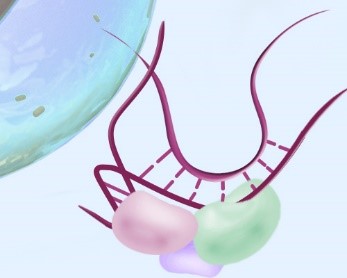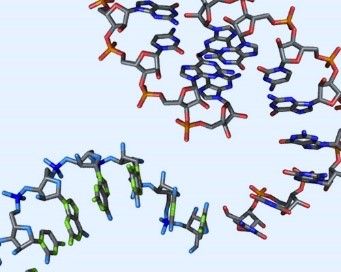At the core of gene expression lies the indispensable role of RNA. This remarkable molecule serves as a molecular courier, transporting vital genetic information from DNA to the ribosomes within cells. Acting as a blueprint, RNA guides the synthesis of proteins with precision. Diverse RNA variants, including messenger RNA (mRNA), transfer RNA (tRNA), and ribosomal RNA (rRNA), perform distinct functions during this intricate protein synthesis process.
In a groundbreaking twist, RNA has recently emerged as a potential therapeutic powerhouse. Armed with the ability to target specific genes or proteins, RNA-based therapies hold immense promise for combating a wide range of diseases. By selectively silencing or degrading targeted RNA, these therapies effectively disrupt the production of specific proteins, paving the way for innovative treatment strategies.
This article delves into the fascinating realm of RNA, unraveling its pivotal role in gene expression and shedding light on its transformative therapeutic applications. Explore how RNA illuminates the intricate machinery of gene expression and discover the remarkable potential it holds for revolutionizing disease treatment.
Powerful RNA Therapeutics
The scope of RNA therapeutics is expanding, offering a diverse array of powerful tools poised to revolutionize disease treatment. Let’s explore some of key RNA therapeutics:
- Small interfering RNA (siRNA): Harnessing the immense potential of siRNA molecules, researchers can precisely silence the expression of specific genes. By targeting and degrading mRNA molecules, siRNA disrupts the translation process, effectively curbing the production of targeted proteins.
- microRNA (miRNA): Masters of gene expression regulation, miRNA molecules skillfully bind to specific mRNA molecules, preventing their translation into proteins. This orchestrated dance of miRNA holds the key to modulating critical cellular functions.
- Antisense oligonucleotides (ASOs): Armed with the ability to modify the splicing of pre-mRNA molecules, ASOs are versatile RNA warriors. By altering gene expression patterns, they navigate the intricate genetic landscape, offering the promise of tailored therapeutic interventions.
- mRNA vaccines: Embarking on a groundbreaking journey, mRNA molecules shine as game-changers in immunization strategies. By encoding viral or cancer antigens, mRNA vaccines stimulate the body’s immune response, triggering a targeted defense against pathogens or malignant cells.
- Ribozymes: Unleashing the catalytic prowess of RNA, ribozymes take center stage as extraordinary molecules. These versatile agents can catalyze specific chemical reactions, offering potential applications in cleaving or modifying targeted RNA molecules within cells.
Revolutionary RNA-based therapies have demonstrated remarkable potential in treating a diverse array of diseases, encompassing specific cancer types, infectious diseases, genetic disorders, and viral infections. These therapies offer a tantalizing prospect of heightened precision and efficiency, surpassing conventional small-molecule drugs by minimizing off-target effects. Nonetheless, certain hurdles remain, including the targeted delivery of RNA to specific tissues and combating the inherent instability of RNA molecules within the body. Nevertheless, the field of RNA therapeutics is rapidly advancing, fostering immense promise for the creation of innovative treatments to address a wide spectrum of diseases.
Enhancing the Synthesis of High-Quality RNA
The synthesis of high-quality RNA is of paramount importance for a wide range of applications, including RNA therapeutics, gene expression analysis, and functional genomics. To achieve this, several strategies and considerations can be implemented:
RNA Synthesis Method: Various methods exist for RNA synthesis, such as chemical synthesis, in vitro transcription, and in vivo transcription. Among these, in vitro transcription is the most commonly utilized technique. It involves utilizing a DNA template and RNA polymerase enzyme to synthesize RNA in vitro.
Template Design: Thoughtful design of the DNA template is crucial for successful RNA synthesis. It should incorporate appropriate promoters, terminators, and ribozyme sequences while avoiding secondary structures, hairpin loops, and self-complementary regions. This ensures efficient and accurate transcription.
Optimization of Reaction Conditions: Optimizing the reaction conditions is vital for achieving efficient transcription and high yields of high-quality RNA. Factors such as temperature, pH, salt concentration, and magnesium concentration should be carefully tuned to promote optimal RNA synthesis.
Purification of RNA: Thorough purification of RNA is imperative to eliminate impurities and contaminants that may compromise RNA quality. Common purification methods include column chromatography, gel electrophoresis, and precipitation techniques.
Quality Control: Rigorous quality control measures should be employed to evaluate the integrity and purity of synthesized RNA. Techniques such as gel electrophoresis, spectrophotometry, and bioanalyzer analysis can be utilized for this purpose.
RNA Modification: Chemical modifications can be introduced to enhance the stability, nuclease resistance, and target specificity of RNA. Widely used modifications include 2′-O-methyl, phosphorothioate, and locked nucleic acid (LNA) modifications.
Synthesizing high-quality RNA necessitates careful attention to the synthesis method, template design, reaction conditions, purification techniques, and quality control procedures. By optimizing these aspects, it becomes feasible to synthesize RNA that is well-suited for a diverse range of downstream applications.
Various techniques can be employed for synthesizing RNA, each with its own advantages and suitability for different RNA molecules. Here are some commonly used techniques:
Solid-phase synthesis: This method involves immobilizing a modified nucleoside onto a solid support, such as a resin. Nucleoside phosphoramidites are then sequentially added in a stepwise manner to construct the RNA sequence. After completion, the RNA is cleaved from the solid support and purified. Solid-phase synthesis is often used for short RNA sequences like aptamers and siRNA.
Solution-phase synthesis: In this approach, RNA is synthesized in a solution using an RNA polymerase enzyme and a DNA template. The RNA polymerase incorporates nucleoside triphosphates (NTPs) to build the RNA sequence. Solution-phase synthesis is commonly employed for longer RNA sequences, such as mRNA and lncRNA.
Chemical synthesis: Chemical synthesis involves assembling RNA nucleotides in solution through chemical reactions like phosphoramidite chemistry or H-phosphonate chemistry. Chemical synthesis is suitable for small RNAs, including miRNA and siRNA.
Enzymatic synthesis: Enzymatic synthesis employs specific enzymes, such as T7 RNA polymerase, to synthesize RNA in vitro. Enzymes incorporate NTPs to extend the RNA chain. This method is often used for synthesizing large RNA sequences, such as mRNA and rRNA.
3D printing: A recent development in RNA synthesis is the utilization of 3D printing technology. This technique employs a 3D printer to deposit RNA nucleotides onto a substrate, building the RNA sequence layer by layer in a predetermined pattern.
RNA synthesis can be accomplished through various techniques, including solid-phase synthesis, solution-phase synthesis, chemical synthesis, enzymatic synthesis, and even 3D printing. The choice of method depends on factors such as the length, complexity, and intended application of the RNA molecule.
Applications
RNA synthesis finds application in various fields, showcasing its versatility and significance in scientific and medical advancements. Here are some notable applications of RNA synthesis:

mRNA vaccines: RNA synthesis plays a crucial role in the development of mRNA vaccines. These vaccines utilize synthetic mRNA to provide instructions to cells to produce viral proteins, triggering an immune response and conferring immunity. COVID-19 vaccines are prominent examples of successful mRNA vaccines.

RNA interference (RNAi) therapy: RNA synthesis contributes to RNAi therapy, a technique that enables targeted gene silencing. By synthesizing small interfering RNA (siRNA) molecules, specific disease-causing genes can be selectively silenced, holding promise for treating various diseases such as cancer, hepatitis C, and macular degeneration.

CRISPR/Cas9 gene editing: RNA synthesis is integral to the CRISPR/Cas9 gene editing system. RNA molecules guide the Cas9 enzyme to the desired gene sequence, enabling precise DNA editing. This technology has revolutionized genetic engineering and holds immense potential for therapeutic applications.

RNA Aptamers: RNA synthesis facilitates the development of RNA aptamers, short RNA molecules with high affinity and specificity for binding to specific targets. These aptamers have diverse applications in biosensors, diagnostics, and therapeutics, offering targeted and specific interactions.

RNA-based diagnostics: RNA synthesis is employed in the creation of diagnostic tools for infectious diseases. RNA extraction and amplification techniques enable the detection of viruses like COVID-19, HIV, and hepatitis C in patient samples, contributing to accurate and timely diagnosis.
Challenges
Stability: RNA molecules are inherently unstable and prone to degradation by nucleases. Protecting RNA from degradation during synthesis, purification, and storage is crucial to maintain its integrity and functionality.
Purity: Contaminants, such as residual DNA, chemicals, or other impurities, can affect the quality and activity of synthesized RNA. Thorough purification methods must be employed to remove these impurities and ensure the desired purity of the RNA molecule.
Yield: Obtaining high yields of RNA, especially for longer sequences, can be challenging. Low yields can limit the amount of RNA available for downstream applications and may require additional optimization steps to improve efficiency.
Chemical modifications: Introducing chemical modifications to RNA molecules can enhance their stability, specificity, or other properties. However, these modifications may impact the efficiency and fidelity of RNA synthesis, requiring careful optimization and evaluation.
Bioactivity: RNA molecules must possess the correct folding and secondary/tertiary structure to be biologically active. Ensuring proper folding and functional RNA structure during synthesis is essential for their effectiveness in interacting with other molecules and carrying out their intended functions.
Sequence fidelity: Errors during RNA synthesis, such as mismatches or truncations, can affect the accuracy and fidelity of the RNA sequence. Maintaining high sequence fidelity is crucial, particularly for applications requiring precise RNA sequences.
Addressing these challenges often requires optimization of synthesis protocols, purification methods, and quality control measures. Advancements in RNA synthesis technologies and methodologies continue to tackle these challenges and improve the overall quality, yield, and bioactivity of synthesized RNA molecules.
Synbio Technologies offers efficient and customizable RNA products and services to meet the diverse needs of researchers. Leveraging their expertise in synthetic biology, they consider various factors such as codon preference, mRNA secondary structure, GC content, and translation efficiency to optimize RNA sequences. They utilize advanced bioinformatics and deep learning algorithms to design sequences that result in improved protein expression content, solubility, and overall performance.
Furthermore, Synbio Technologies provides tailored synthesis services for RNA molecules of different lengths, specifications, modifications, and labeling options. This flexibility enables researchers to obtain high-quality RNA products for gene function analysis and the development of therapeutic strategies.
The advancements in RNA synthesis facilitated by companies like Synbio Technologies hold tremendous potential for precision medicine. The ability to rapidly and efficiently produce RNA molecules with specific sequences enables the development of personalized therapies and diagnostics. By customizing treatments based on an individual’s genetic and molecular characteristics, precision medicine offers more targeted and effective approaches to patient care.
As the field of RNA synthesis continues to evolve, it is expected to play an increasingly critical role in driving advancements in precision medicine and revolutionizing the way diseases are diagnosed and treated.
Reference
[1] Beck J D, Reidenbach D, Salomon N, et al. mRNA therapeutics in cancer immunotherapy[J]. Molecular cancer, 2021, 20(1): 1-24.[2] Geall A J, Mandl C W, Ulmer J B. RNA: the new revolution in nucleic acid vaccines[C]//Seminars in immunology. Academic Press, 2013, 25(2): 152-159.[3] Shin H, Park S J, Yim Y, et al. Recent advances in RNA therapeutics and RNA delivery systems based on nano particles[J]. Advanced Therapeutics, 2018, 1(7): 1800065.

